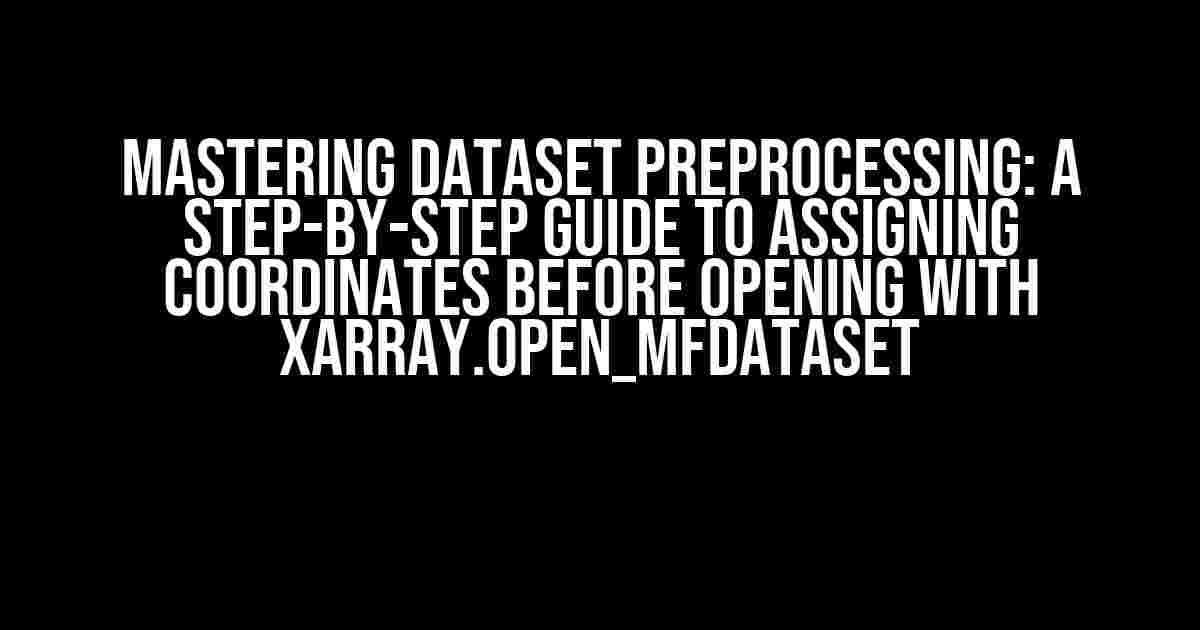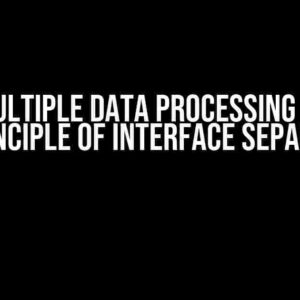Are you tired of struggling with uncoordinated datasets? Do you find yourself lost in a sea of chaotic data, unsure of how to assign coordinates before opening with xarray.open_mfdataset? Fear not, dear data enthusiast! In this comprehensive guide, we’ll take you by the hand and walk you through the process of preprocessing your dataset to assign coordinates like a pro.
Why Preprocess Datasets?
Before we dive into the nitty-gritty, let’s talk about why preprocessing datasets is crucial. Preprocessing involves cleaning, transforming, and preparing your data for analysis. This step is essential because it helps:
- Remove inconsistencies and errors in the data
- Improve data quality and integrity
- Enhance data visualization and interpretation
- Boost model performance and accuracy
Understanding xarray.open_mfdataset
xarray.open_mfdataset is a powerful function in the xarray library that allows you to open multiple NetCDF files and concatenate them into a single dataset. However, for this function to work its magic, your dataset needs to be properly preprocessed and assigned coordinates.
What are Coordinates in xarray?
In xarray, coordinates are essential metadata that provide context to your dataset. They can be thought of as axes or dimensions that help you navigate and manipulate your data. Common coordinates include:
- Time
- Latitude
- Longitude
- Depth
- Height
Step-by-Step Guide to Preprocessing Datasets for xarray.open_mfdataset
Now that we’ve covered the basics, let’s get our hands dirty! Follow these steps to preprocess your dataset and assign coordinates before opening with xarray.open_mfdataset:
Step 1: Inspect Your Dataset
The first step is to inspect your dataset and understand its structure and content. Use the following code to load your dataset into a pandas DataFrame:
import pandas as pd
df = pd.read_csv('your_dataset.csv')Explore your dataset using various methods like df.head(), df.info(), and df.describe() to get a sense of its shape, size, and content.
Step 2: Handle Missing Values
Missing values can be a major obstacle in data analysis. Use the following strategies to handle missing values:
- Drop rows or columns with missing values:
df.dropna() - Replace missing values with mean, median, or mode:
df.fillna(df.mean()) - Interpolate missing values:
df.interpolate()
Step 3: Data Transformation
Data transformation involves converting your data into a suitable format for analysis. Common transformations include:
- Converting data types:
df['column'] = df['column'].astype('float64') - Scaling or normalizing data:
from sklearn.preprocessing import StandardScaler; scaler = StandardScaler(); df[['column1', 'column2']] = scaler.fit_transform(df[['column1', 'column2']]) - Encoding categorical variables:
df['category'] = pd.get_dummies(df, columns=['category'])
Step 4: Assign Coordinates
This is the most critical step in preprocessing your dataset for xarray.open_mfdataset. You need to assign coordinates to your dataset, which will serve as axes for your data. Use the following code to assign coordinates:
import xarray as xr
# Create a DataArray from your DataFrame
da = xr.DataArray(df.values, dims=['time', 'lat', 'lon'], coords={'time': df.index, 'lat': df['latitude'], 'lon': df['longitude']})
# Convert the DataArray to a Dataset
ds = da.to_dataset(dim='time')In this example, we’ve assigned ‘time’, ‘lat’, and ‘lon’ as coordinates to our dataset.
Step 5: Save Your Preprocessed Dataset
Finally, save your preprocessed dataset to a NetCDF file using:
ds.to_netcdf('preprocessed_dataset.nc')Opening Your Preprocessed Dataset with xarray.open_mfdataset
Now that you’ve preprocessed your dataset and assigned coordinates, you can open it using xarray.open_mfdataset:
import xarray as xr
ds = xr.open_mfdataset('preprocessed_dataset.nc')Voice of excitement! You’ve successfully preprocessed your dataset and assigned coordinates before opening it with xarray.open_mfdataset. You can now explore your dataset, visualize your data, and perform advanced data analysis tasks.
Conclusion
Preprocessing datasets is an essential step in data analysis, and assigning coordinates is a critical part of this process. By following the steps outlined in this guide, you’ll be able to preprocess your dataset, assign coordinates, and open it with xarray.open_mfdataset. Remember, a well-preprocessed dataset is the key to unlocking insights and making meaningful discoveries.
| Skill Level | Beginner | Intermediate | Advanced |
|---|---|---|---|
| Dataset Preprocessing | |||
| xarray.open_mfdataset | |||
| Coordinate Assignment |
Rate your skills and come back to this guide as you progress in your data analysis journey!
Frequently Asked Questions
Q: What if I have multiple datasets? Can I preprocess them separately and then combine them?
A: Yes, you can preprocess each dataset separately and then combine them using xarray.concat or xarray.merge.
Q: How do I handle datasets with different coordinate systems?
A: You can use xarray’s built-in functionality to handle datasets with different coordinate systems. For example, you can use xarray.DataArray.reindex or xarray.Dataset.reindex to align your coordinates.
Q: What if I’m working with large datasets? How can I optimize my preprocessing workflow?
A: You can use xarray’s chunking feature to optimize your preprocessing workflow for large datasets. Chunking involves dividing your dataset into smaller chunks and processing them in parallel.
Get Started with Preprocessing Your Dataset Today!
Don’t let uncoordinated datasets hold you back any longer. Follow the steps outlined in this guide to preprocess your dataset, assign coordinates, and open it with xarray.open_mfdataset. Happy data analyzing!
Frequently Asked Question
Get ready to dive into the world of dataset preprocessing and xarray.open_mfdataset! Below, we’ve got the most frequently asked questions about assigning coordinates before opening your dataset.
Q1: Why do I need to preprocess my dataset before opening it with xarray.open_mfdataset?
Preprocessing your dataset is essential to ensure that your data is in the correct format and structure for xarray.open_mfdataset to work its magic! This step helps to clean, transform, and prepare your data for analysis, making it easier to work with and reducing errors.
Q2: What kind of preprocessing steps are necessary for assigning coordinates?
Typically, you’ll need to perform steps like data cleaning, handling missing values, data normalization, and feature scaling. Additionally, you might need to convert your data into a suitable format, such as NetCDF or HDF5, and ensure that your data has a consistent structure and naming convention.
Q3: How do I assign coordinates to my dataset?
You can assign coordinates to your dataset by creating a DataArray or DataFrame with the desired coordinates and then merging it with your original dataset. Alternatively, you can use xarray’s built-in functions, such as xarray.DataArray.assign_coords() or xarray.Dataset.assign_coords(), to add coordinates directly to your dataset.
Q4: What are some common issues that might arise during preprocessing and how can I troubleshoot them?
Common issues include data format errors, inconsistent naming conventions, and missing or duplicate values. To troubleshoot, try checking your data’s structure and format, verifying that your coordinates are correctly assigned, and using xarray’s built-in functions for data manipulation and cleaning.
Q5: Are there any best practices for preprocessing datasets for xarray.open_mfdataset?
Yes! Best practices include keeping your dataset organized, using consistent naming conventions, and documenting your preprocessing steps. Additionally, it’s essential to verify that your dataset is in the correct format and structure for xarray.open_mfdataset and to test your dataset before opening it with the function.


